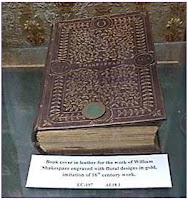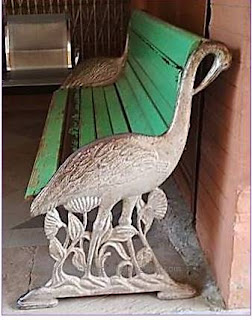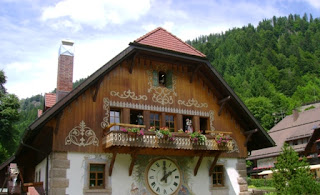Visiting Baroda Museum and Picture Gallery – a travel guide and review
The Baroda Museum and Picture Gallery, known simply as the Vadodara Museum, is located adjacent to the Sayaji Baug public garden. Commissioned in 1894 by Sayajirao with instructions to the architect R. F. Chisholm to have it on the same lines as UK’s Victoria and Albert museum, it showcases his collections from around the world.
You will thus see paintings and coins, dining sets and ivory miniatures, musical instruments and rare books. Various websites and reviews prominently mention an Egyptian mummy and a skeleton of a blue whale as the premier showpieces. Actually, there are other far more worthy displays than those. Let’s take a quick tour…
After purchasing the ticket, check out the neat little Shilp Udyan (sculpture park) located just behind the ticket booth.
 |
| Shilp Udyan |
 |
| Urn that carried Gandhiji's ashes |
In the main hall are also the famous 5th Century A.D. Akota bronzes of Jain sculptural art works.
 |
| Akota Bronzes |
Some of the various sections in the museum with a few highlights are -
1. Greater India Room
2. Islamic Gallery: Inscriptions, seals, manuscripts
3. Zoology: Bird Gallery: A collection of stuffed animals and birds.
4. Egyptian Gallery
5. Japanese Gallery: Coins, ivory figurines; don’t miss the fascinating
incense burner and the charming figurine of a bride dressed in a Kimono of embroidered silk.
 |
| Ivory figurines in Japanese Gallery |
6. Tibetan Gallery - Check out the gigantic 'Mandala' which is a said to be a geometric pattern of symbols representing the Cosmos.
 |
| Mandala in Tibetan Gallery |
7. Old Baroda Room – Baroda State Arms; full-sized doors
8. The Picture Gallery – This was added much later in 1910 and displays water colours and oil paintings of global artists. Don't miss the stained glass windows at the entrance of the Gallery
Unique displays-
A most unusual framed panel was the picturization of a possible folk tale; unusual because this was labeled on the frame as 'An Unidentified Story'. Intriguing to know that there is a story that is not known! This particular one is etched in gilt copper and semi-precious stones.
 |
| Story panel |
Don't miss the preaching Buddha-
 |
| The Preaching Buddha |
I was glad I took this particular photo as it seems it is a rare gilt bronze image. The Buddha image measures approximately 20cm in height and the face, hands, and feet are gilded. The preaching gesture with the two hands in front of the solar plexus is performed with the left middle finger pointing to the circle made by the right hand. The drapery covers both shoulders and displays peculiar concentric U-shape folds. The Buddha sits on a lotus pillow placed on top of the square base of a throne which shows a lion trampling on an elephant at each corner. The Buddha’s feet rest on a lotus pedestal supported by a thick stalk and two buds.
- Information credit: Nicolas Revire. The Enthroned Buddha in Majesty: an Iconological Study. Religions. Université Sorbonne Paris Cité, 2016. English. [https://tel.archives-ouvertes.fr/tel-01552082/document]
Personal Review
Other than the Japanese Gallery, we loved the costume section-
 |
| Costume Gallery |
And one of my favourite ivory pieces was this one-
Guess what it is!
While we were pretty impressed with some of the displays, somehow we felt it could have been better curated. We did not quite understand, for example, the need for the Zoology section in a museum that primarily houses historical artefacts. There was also the section in the picture gallery where we see artefacts of a particular type, then suddenly there is an embroidered piece next to that cabinet and then we enter a room filled with statues. It was also odd to see, for example, a book next to cutlery and, next to that cabinet, stained glass panels.
The kind of smooth flow that we experienced in other museums was lacking here.
It would also be good if there were prominent signs near the glass cabinets, warning visitors not to touch them. Quite a few people were pressing their fingers on the glass, pointing to something inside, thereby leaving fingerprint smudges. Another irritation was that children were constantly running around and shouting in the areas of the picture gallery in the center of the rooms. While it is the responsibility of accompanying adults to rein them in, the staff could also be requested to ensure some kind of decorum by visitors. Talking and chattering is fine in a museum, but it would be good not to treat it as though it is a playground.
Baroda Museum and Picture Gallery Timings
10.30 a.m. to 5 p.m. No entry will be permitted into the compound after 5 p.m. and those visitors who are inside the museum must exit at 5.30 p.m. The museum is open on all days, except important holidays.
Baroda Museum and Picture Gallery Entry fees
- For Indians: Rs.10/- per person above four years of age.
- For foreigners: Rs.200/- per person above four years of age.
- Concessional fee: Rs.5/- per person for organized groups schools and colleges, but only on production of a certificate.
- Free entry: On the Board on the Gate, it was mentioned that free entry will be given on Fridays for Senior citizens with one accompanying child.
- Photography fee: Rs.100/- per camera used to take photos.
- Videography fee: Rs.500/- per video camera used to film, but should be non-professional videography.
- Services of a guide are provided free of charge.
Rules
- You are not allowed to take photos or videos without payment of the fees as mentioned above (the image on the left is the 'permission ID'. In case you are not paying the fee, then you must deposit your camera at the cloak room and take a token for it.
- Do not touch any of the objects on display and avoid talking loudly and disturbing other visitors.
- Do not take inside eatables, beverages and inflammable materials.
- Smoking and alcohol is strictly prohibited on the entire premises.
- Leave your luggage (backpacks, large bags, and the kind) to the guard just outside the entrance of the museum building and take a token for it. Remember to pick it up on finishing the museum tour and check it. Do not lose the token, otherwise you will have to pay a fine.
And if you missed the storks while entering, check it out while leaving!
Baroda Museum and Picture Gallery Address-
University Rd, Dak Bungalow,
Sayajiganj,
Vadodara,
Gujarat-390018.
[Footer - that ivory piece in the cabinet that I loved is a coin box!]










Thanks for a nice reminder of the museum - I loved it and would like to revisit one day.
ReplyDelete